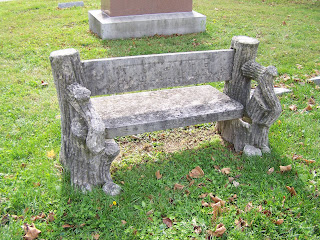This is a consolidation of a 10-page paper I did for an anthropology class. More articles on cemetery observations to follow.
-------------------------------------------------------------
In a recent anthropology class project, I went to local cemeteries to research tombstone symbols. Cemeteries are a GREAT source of historical information, not just names and dates of the people who lived before us, but can also give a picture of the social changes over the years.
One symbol is the use of wood, trees or logs in the monument. Trees represent life. Cut trees, tree trunks, logs, etc., represent life cut short. Going through one of the larger cemeteries in Indianapolis, Crown Hill Cemetery, I counted 37 of these log-design benches within a small area. It was an older area with life-span dates of the early to late 1800s.
One symbol is the use of wood, trees or logs in the monument. Trees represent life. Cut trees, tree trunks, logs, etc., represent life cut short. Going through one of the larger cemeteries in Indianapolis, Crown Hill Cemetery, I counted 37 of these log-design benches within a small area. It was an older area with life-span dates of the early to late 1800s.
 In the 1800s, people traveled on horseback, in wagons and on foot, to visit the graves of their deceased family members. The benches provided a place for the mourner to rest while spending time at the gravesite.
In the 1800s, people traveled on horseback, in wagons and on foot, to visit the graves of their deceased family members. The benches provided a place for the mourner to rest while spending time at the gravesite.These benches were usually the marker for the family plot, with the family name on the back railing. Individual stones near the bench carried just the first name and the birth/death year. Sometimes, the smaller headstone would have a relationship designation, such as "mother" or "son".
As time went on , the wood/log design fell to the wayside and the benches became more modern, taking on a modern and sometimes Roman design. I noticed these were fewer in number than the log benches, leading me to assume bench-tombstone markers may have been a fad or fashion of a specific time.

In the mid 1900s most people owned cars and driving to the cemetery was near the chore that it was in the 1800s. People were not tired after their journey and perhaps the need for a place to rest and "visit" was not as necessary. Headstones evolved to this new cultural and social change.
Perhaps in the sense of "all things old are new again", I came across this marble bench stone that is doing double duty. It serves as the individual's headstone, the family plot marker, and a bench for the mourners to sit and rest. This was the only type of bench-headstone I saw in the newer section of the cemetery.



No comments:
Post a Comment